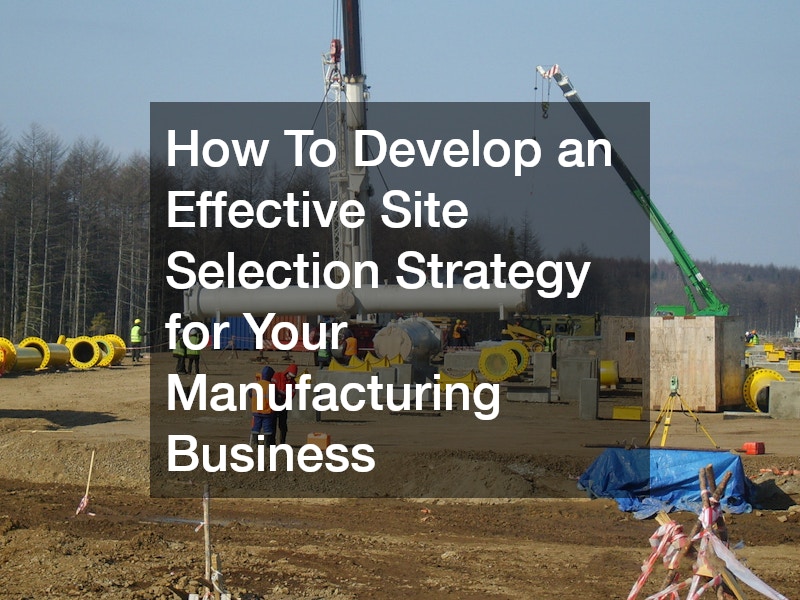Choosing the right site for your manufacturing business is one of the most critical decisions you’ll ever make. The location you select can significantly impact operational efficiency, accessibility, long-term growth potential, and your return on investment. This decision isn’t just about finding available land. It’s about aligning your goals, budget, and infrastructure needs with a location that will support your business now and in the future. An effective site selection strategy requires careful planning, expert collaboration, and thoughtful analysis of many different factors, all of which contribute to a comprehensive site selection strategy.
In this guide, we’ll walk you through a structured framework for developing a smart and effective strategy for selecting a manufacturing site. From defining your goals and evaluating physical land features to navigating regulations and assessing building potential, this blog will help ensure you’re making informed decisions at every step. It’s not just about picking a spot and breaking ground. You’ll need to think about zoning restrictions, future development potential, structural integrity, ease of access, and the total cost of developing and operating the site.
Whether you’re acquiring land for the first time or expanding an existing operation, understanding how to develop a successful site strategy is essential to protecting your investment and ensuring long-term operational success.
1. Define Your Goals

Before you can make any informed decisions about where to build your manufacturing facility, you need to define your business goals clearly. These objectives will shape your priorities during site selection, from the size of the lot you need to proximity to supply chains or labor markets. Consider both your current operational needs and your future growth plans.
One of the most critical early decisions is how the property will serve your specific functions. Will you need space for expansion? What type of production equipment or materials handling will the site need to accommodate? Do you need space for employee parking, loading docks, or specialized machinery? Answering these questions helps ensure you’ll be able to make the best use of your land instead of discovering too late that it’s too restrictive or requires costly modifications.
A well-structured site selection strategy should begin with matching your operational objectives with your physical space requirements. This means considering everything from layout efficiency to the relationship between different functional zones. By aligning your long-term business strategy with your site from the beginning, you position your company to grow into the space rather than outgrow it too soon. Ultimately, setting goals isn’t just a planning exercise—it’s the foundation that supports every other decision you’ll make.
2. Evaluate the Land
Once your goals are defined, the next logical step is evaluating the physical characteristics of the land you’re considering. Not all parcels are created equal. Soil composition, elevation, drainage, and surrounding topography can have significant implications on construction costs and timelines. What appears to be a “good deal” might come with hidden issues that turn into expensive problems. That’s why careful evaluation of a property’s physical state is essential before proceeding.
This is where experts like commercial land appraisers can play a vital role. They assess land not only based on size and location but also based on zoning, market trends, environmental risks, and comparative value. Their reports can also help you understand a property’s long-term value and guide negotiation strategies if you’re purchasing the land.
Including a land evaluation component in your site selection strategy helps you make decisions based on facts rather than assumptions. It gives you clarity about whether the site supports your building needs and financial constraints. With a proper land assessment, you can avoid costly surprises and confirm the land’s suitability before making a major investment.
3. Survey the Property

After identifying suitable land and reviewing its appraised value, the next step involves a detailed property survey. This process goes beyond basic boundaries—it includes examining elevation, potential obstacles, existing utilities, and proximity to flood zones or environmental hazards. Property surveys help create a clear picture of what you’re working with and help prevent legal disputes or development delays later on.
Working with local structural engineers during this phase adds technical insight into how the land can physically support your facility. These professionals assess load-bearing potential, subsurface stability, and whether the existing conditions are compatible with the structural demands of a manufacturing facility. Their feedback is crucial for understanding what adjustments or reinforcements might be necessary to safely and efficiently build on the land.
Incorporating structural assessments into your site selection strategy means you’re proactively identifying red flags before construction begins. Engineers can identify risks that may not be obvious during visual inspections or standard surveys, and their recommendations can influence the overall site layout and budget. Ultimately, this step ensures your chosen property isn’t just buildable—it’s optimal for your business’s specific operational and structural needs.
4. Check Local Codes
Understanding local zoning laws and building regulations is a vital part of the site selection process. These rules can restrict or influence the type of facility you can build, its size, its height, and how it can be used. In some cases, certain industrial activities may be outright prohibited in specific zones. Overlooking these factors can lead to serious delays or even stop a project in its tracks, making code research a necessary early step.
To navigate these complex requirements, partnering with commercial architects is invaluable. These professionals not only design functional and efficient facilities but are also deeply familiar with municipal codes and permitting processes. They can help interpret local ordinances and create designs that comply with both legal standards and your operational needs. In addition, they often have relationships with local planning departments, which can streamline approvals and prevent costly revisions.
A strong site selection strategy includes compliance as a core consideration, not an afterthought. Making sure your project adheres to local codes from the outset reduces risk and enhances efficiency. With architects guiding the process, you can be confident that your facility will be both legally compliant and optimally designed to support your manufacturing goals.
5. Analyze Site Access

Accessibility can greatly influence the daily function of your manufacturing site. Considerations like road conditions, traffic flow, and access to highways or rail systems can affect shipping schedules, employee commutes, and supplier deliveries. Additionally, during construction, access routes must support the transport of heavy equipment and materials. If access is restricted or complicated, it can slow progress and raise costs.
One often overlooked aspect of site access is the availability and coordination with crane rental companies. These companies play a pivotal role during construction, especially if your project involves installing large structural elements or heavy machinery. Their ability to safely deliver and position equipment on-site depends on having adequate space, staging areas, and clearance—all of which need to be factored into your access analysis early.
By including access logistics in your site selection strategy, you can better prepare for the realities of both construction and operations. Considering how vehicles, deliveries, and large equipment will enter and leave the property ensures a smoother development process and minimizes future disruptions. A site that looks great on paper might be completely impractical if it’s too difficult to reach efficiently.
6. Plan Site Layout
Once a property’s physical features and legal requirements have been evaluated, the next major step is planning how your facility will be laid out on the site. This includes placement of buildings, parking, loading docks, green space, stormwater drainage, and internal traffic flow. A poor layout can lead to inefficiencies, safety concerns, or difficulties expanding in the future. Smart layout planning turns raw land into a well-organized and productive asset.
Working with professionals in commercial industrial construction ensures that your layout is not only functional but also feasible to build. These experts understand the unique needs of industrial sites, from large clear spans to proper foundation support. They help balance building code requirements with practical space usage, ensuring that your site functions efficiently and safely under real-world operating conditions.
A detailed layout plan is a critical part of your site selection strategy because it ties together everything you’ve learned about the land and your business needs. The layout determines how people, goods, and equipment move through the site, and those movements impact productivity and safety. By planning with construction professionals early, you avoid costly retrofits and set the stage for a site that works from day one.
7. Estimate Land Value

Estimating land value isn’t just about checking the price tag—it’s about understanding what you’re getting for that price. Location, zoning, access to infrastructure, and nearby developments all influence a parcel’s market value. Accurately estimating land value helps you compare different properties objectively, avoiding overpriced lots that don’t meet your operational needs or financial goals.
When reviewing options, you’ll likely come across various listings for commercial property for sale, but price alone doesn’t tell the full story. The value of a parcel includes intangibles such as location advantages, long-term appreciation potential, and how easily it can be developed. You’ll want to consider surrounding land use and possible changes in the area’s economic conditions or regulatory landscape, all of which affect whether a property is a good long-term investment.
A thorough evaluation of land value is an essential part of any site selection strategy. Choosing a site based solely on initial cost could cost you more in the long run due to hidden development challenges or limited expansion opportunities. Taking a strategic approach to land value helps ensure that your investment is aligned with both your current budget and your long-term business vision.
8. Assess Build Options
Once you’ve narrowed down a piece of land and its potential value, it’s time to consider how your facility will be constructed. There are multiple approaches to industrial construction—custom builds, modular systems, or phased rollouts—all of which come with their pros, cons, and timelines. Your building method will directly affect construction cost, operational flexibility, and the time it takes to get up and running.
By researching similar development projects in the area, you can gain insights into what works and what doesn’t in that region. Local trends may influence architectural style, infrastructure needs, or construction techniques. Studying these projects helps you benchmark your plan. From there, you can make informed decisions about the size, structure, and staging of your facility.
Factoring construction options into your site selection strategy ensures your land and building plans are in sync. You don’t want to secure a site only to learn that your ideal building design isn’t possible due to soil limitations or local code restrictions. Exploring build options early helps you match your construction plan to the physical and regulatory landscape of your selected site.
9. Review Site Costs
Many businesses underestimate the total cost of preparing a site for construction. Beyond purchasing the land, there are additional expenses like grading, utility installation, stormwater management, and exterior surfacing. Overlooking these costs during planning can cause major financial strain once development begins, especially for first-time facility builders.
One major cost that often arises during preparation is the need for paving services. Access roads, loading zones, parking areas, and even interior yard spaces must be paved to meet safety and durability standards. The extent and complexity of paving depend on the land’s slope, soil type, and the expected weight loads. Neglecting to budget for this can lead to project delays or safety issues post-construction.
Your site selection strategy should include a full accounting of site prep and development costs, not just the visible expenses. By including things like paving, drainage systems, and grading in your early budgeting, you reduce the likelihood of budget overruns and construction setbacks. Proper cost forecasting ensures a smoother development phase and a facility that performs reliably from day one.
10. Prepare for Groundwork
Before any concrete is poured or steel is erected, the site must be physically prepared. This process can be more complex than it seems. Site clearing, grading, trenching, and soil stabilization are essential to ensure a strong foundation and a safe build environment. Ignoring early groundwork steps can lead to structural problems, drainage issues, or expensive corrective work down the road.
Partnering with a reputable excavating company helps manage these risks effectively. These professionals assess soil conditions, remove debris, reshape the terrain, and dig for utilities or foundations. Good excavation work ensures that what’s built on top is solid, secure, and durable.
Incorporating excavation and site prep into your site selection strategy allows for accurate budgeting, realistic timelines, and better planning. Identifying land that requires minimal groundwork can reduce costs and accelerate the construction schedule. It’s important to understand what’s beneath the surface before breaking ground.
Choosing where to build your manufacturing facility is a decision that will shape your business for years to come. From finding land that supports operational needs to ensuring it complies with local regulations, a well-thought-out site selection strategy is vital. Every step from evaluating the land’s physical characteristics to aligning with logistical and regulatory realities plays a role in determining the project’s ultimate success.
Developing a site for your manufacturing business is about more than picking a piece of land. It’s about creating the conditions for long-term operational success. A robust site selection strategy helps you reduce risks, manage costs, and build for the future. With the right planning, the right team, and the right location, you’ll be well on your way to transforming a raw plot into a powerful production asset for your business.


